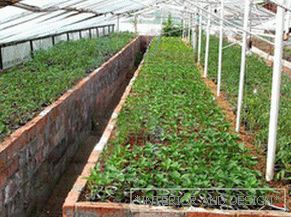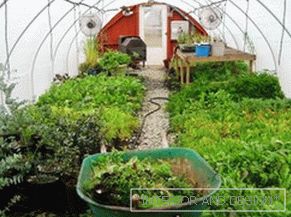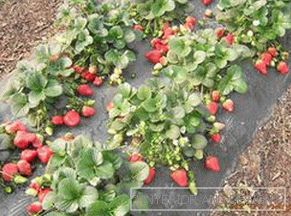 Greenhouse on the garden, garden, cottage or backyard is not just a fashionable trend or someone's fad. For some, greenhouse is a hobby, for someone and a source of additional or even basic income. In addition, having a greenhouse, you can always provide a table with fresh, environmentally friendly products containing vitamins. In winter and early spring, avitaminosis does not threaten greenhouse owners and their family members.
Greenhouse on the garden, garden, cottage or backyard is not just a fashionable trend or someone's fad. For some, greenhouse is a hobby, for someone and a source of additional or even basic income. In addition, having a greenhouse, you can always provide a table with fresh, environmentally friendly products containing vitamins. In winter and early spring, avitaminosis does not threaten greenhouse owners and their family members.
The best option on the site is a heated polycarbonate greenhouse. It not only becomes all-season, but also protects plants from phytophthora.
Beginners and inexperienced gardeners often ask the question: what to plant? And, in particular, what to plant in the greenhouse for the winter? It makes sense to answer the last question in an expanded form.
Content
- 1 Preliminary information
- 1.1 Requirements for planting crops
- 1.2 Crop classification
- 2 Examples of plant selection
- 2.1 Greenery
- 2.2 Vegetables and root vegetables
- 2.3 Fruits, berries
- 2.4 Flowers
- 3 Conclusion
Preliminary information
Requirements for planting crops
- expediency;
- rationality;
- profitability.
So, expediency. Do you need this or that culture? And where will you put the surplus, if any, formed due to improperly planned landing volumes?
Rationality implies the correctness of the timing and volume of planting, the use of optimal agricultural practices. When choosing a crop, it is necessary to decide in advance how real the owner’s abilities are to create optimal conditions for growing this sample.
Expediency and rationality are also provided the right choice of varieties grown crops. Having correctly selected the structure and arrangement of the greenhouse, having rationally planned the change of plants on the greenhouse bed, it is possible to achieve effective year-round functioning of this green conveyor.
What is profitability, explain, probably, is not required. This criterion is important for those who decide to extract income from the greenhouse. Greens and flowers, in terms of profitability, are almost the same. But greens are a solution to the problem of winter deficiency of vitamins, flowers are bright shades in the autumn and winter landscape, joy and a peaceful atmosphere in the house.
Crop classification
Cultures grown in greenhouses can be divided into types:
-
 greenery;
greenery; - vegetables;
- roots;
- fruits;
- berries;
- medicinal plants;
- flowers and other ornamental plants.
When organizing a rational process, plants planted in greenhouses, classified into the following groups:
- Ancestral cultures, which serve as ripening cold-resistant vegetables and greens. Examples: early carrots (early), radishes, spinach, dill.
- Basic culture. They can be tomatoes and cucumbers, sweet peppers and eggplants.
- Intermediate cultures are used to fill the space not occupied by the main plantings. As it grows and develops, the main culture gradually supersedes the intermediate one. This technique ensures the rational use of greenhouse space.
- Subwinter culture. Examples: sorrel, chicory, parsnip.
In addition to herbal food, medicinal and ornamental plants can be grown in the greenhouse. And for myself and, especially, for sale. Examples: roses and peonies, dahlias, nasturtiums, asters.
Examples of plant selection
Greenery
Inexpressible, gives several yields per year. Greenhouses may be unheated.
-
 Bow. The plant is valued for its not only taste, but also healing properties. Growing this crop is not something difficult, but it requires the right choice of variety. Recommended multi-varieties such as Bessonovsky, Rostov, Ryazan, Skopinsky.
Bow. The plant is valued for its not only taste, but also healing properties. Growing this crop is not something difficult, but it requires the right choice of variety. Recommended multi-varieties such as Bessonovsky, Rostov, Ryazan, Skopinsky. - Parsley. It is almost as popular as onion in terms of popularity, although it is more fastidious to environmental conditions (lightness of space, fertilization of soil). It is stable by the cold, but it has long germination periods.
- Dill. Also located among the most popular plants candidates for pre-winter planting in the greenhouse. One of the most profitable crops grown for sale.
- Sorrel. Due to the slow growth of this plant it should not be planted on the main greenhouse beds. First you need to germinate it in the boxes, standing in the aisles of the greenhouse. Then sprouts are exposed to the light. The first harvest can be obtained in 20-25 days, the subsequent removal of products from the garden — in 15 days.
- Other greens are spinach, mint, basil, salads, nettle, onion, and many more different types.
Vegetables and root vegetables
Most popular type of greenhouse plants.
- Carrot. Long-term germination of seeds of this crop makes it an excellent candidate for pre-winter planting in the greenhouse.
- Radishes, beets should be selected from varieties resistant to bolting. The resistance of the selected varieties to cold also does not hurt.
- Tomatoes. Polycarbonate greenhouses or greenhouses are most suitable for growing these vegetables. The plant is thermophilic, the temperature when planting a seedling should not be less than 20 degrees Celsius, otherwise there will be no fruit. At the beginning of growth requires frequent watering, but high humidity is not recommended. A lot of light is an indispensable condition for the growth and ripening of tomatoes. Heaters must be installed in the greenhouse. Fertilizer consumption in winter is extremely small, but potassium is indispensable. Moreover, the main feeding falls on the period of growth.
- Other crops are sweet peppers, eggplants, cucumbers, zucchini, early potatoes. It is important to remember: by the end of winter, vegetables cease to produce fruit. Therefore, on the same soil it is necessary to alternate the plants. So, tomatoes should replace cucumbers, cabbage should change peppers.
Fruits, berries
-
 Strawberry. A berry is very desirable in winter, but, alas, if it is planted in the greenhouse in the fall from the very “scratch”, then the hosts will only have a harvest in spring. Therefore, it is recommended to take seedlings from biennial plants or from the whiskers of the past season. Greenhouse can be both glass and polycarbonate. The soil is not alkaline, only neutral or slightly acid. Humus or fertilizer with a layer thickness of 15 cm is the key to obtaining tasty and juicy berries.
Strawberry. A berry is very desirable in winter, but, alas, if it is planted in the greenhouse in the fall from the very “scratch”, then the hosts will only have a harvest in spring. Therefore, it is recommended to take seedlings from biennial plants or from the whiskers of the past season. Greenhouse can be both glass and polycarbonate. The soil is not alkaline, only neutral or slightly acid. Humus or fertilizer with a layer thickness of 15 cm is the key to obtaining tasty and juicy berries. - Watermelon, melon from the greenhouse "in the icy winter season" is not only a delicacy, but also a source of scarce vitamins.
Flowers
- Roses. Most часто выбираемый вид декоративных растений. Ещё бы, роза—королева цветов. Это растение не только красиво, но и пользуется постоянной популярностью в любое время года, хотя в открытом грунте после сентября не цветёт. Поэтому её выращивание зимой в теплице целесообразно и выгодно. Уход—своевременные удобрение, поливка и обрезание кустов. Устойчивые к болезням и подходящие к выращиванию в теплице сорта: Грандифлора, Флорибунда, Little Flirt, Skarlet Gem, Beauty Secret и чайно-гибридные Pascali, Baccara, Casanova и Carina. Roses, выращиваемые на собственном корне, растут медленнее привитых, но имеют гораздо больше бутонов.
- Peonies, lilies, asters, dahlias and other flowers. These ornamental plants are not as popular as roses, but they will find their admirers among gardeners and buyers of their products.
Conclusion
It is difficult in the framework of a small article to give an exhaustive answer to the topic raised. Moreover, as we study this issue, the thought involuntarily arises that in the winter you can grow everything in a greenhouse! Well, based on the recommendations and information provided here from other sources, every gardener, according to the advice in the first section, should be guided in the choice of crops by expediency and profit.



